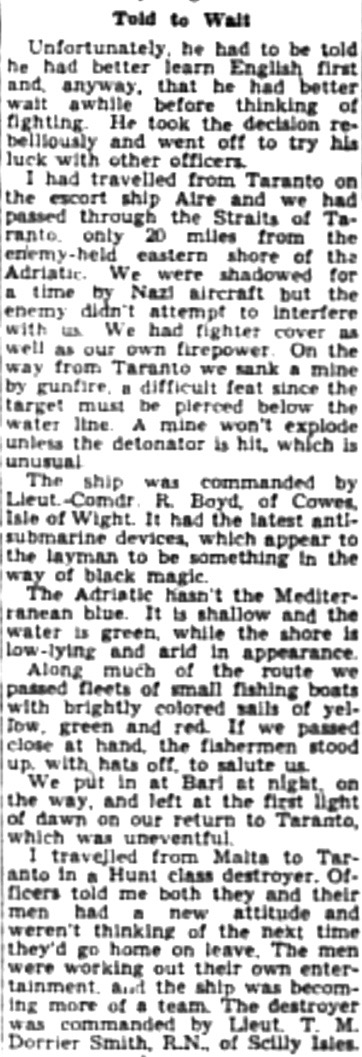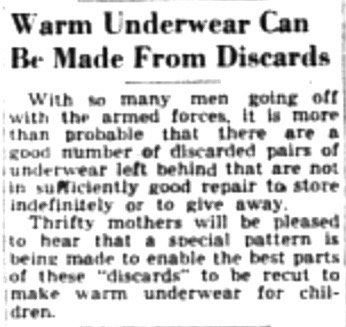Good News? Not One But Two Articles by Sholto Watt
Lots of apparent good news on the front page, October 12, 1943
Above the central photo we read "Good News: Our (i.e., Allied) Planes and Ships Move Into Azores". It's good news because the UK will find it easier to hunt U-Boats.
As well, below the centre fold of The Star I spotted a column by Sholto Watt, war correspondent for the prestigious Montreal newspaper, the man I have been trying to track down to see if he travelled from Messina, Sicily to Reggio, Italy in the Canadian Flotilla of Landing Crafts. (Maybe he sat next to my father!)
In a previous column (see next clip; delayed by over 3 weeks) he viewed Reggio from a height in Messina on the day before our landing crafts were involved in the initial invasion of Italy, i.e., the early morning of September 3, 1943 (Operation Baytown).
Sholto Watt's last paragraphs from an article in the
Sept. 29 issue of The Montreal Star
Sept. 29 issue of The Montreal Star
I anticipated that his next column would describe his seven-mile trip to Reggio with the first landings of Allied troops on the toe of the boot of Italy. Unfortunately, I anticipated incorrectly. Somehow, Mr. Watt found his way onto a destroyer instead... on the opposite side of the Italian peninsula! How did that happen?
I'm not sure at the moment, and will continue to search for more articles and possible answers. If readers can find any clues that tell of the movements of Sholto Watt, please feel free to contact me at gordh7700@gmail.com
After the first column by Mr. Watt (the next news clips), readers will find more clips and editorial material (and an exciting Pepsi advert) from the Oct. 12 - 15 issues of The Star (including a second article by Sholto Watt). There are still highs and lows in Allied progress in Italy and other war fronts as World War II continues as one tough slog.
Mr. Watt is the first war correspondent I have read about who had such a long journey on a Motor Torpedo Boat (i.e., 800 miles on an MTB). Admittedly, if that trip was offered to me instead of a seven mile trip on an LCM (Landing Craft, Mechanised), I'd be tempted too, unless my father was aboard the LCM : )
MTB's actually played some role in enticing at least one young member of RCNVR into volunteering for Combined Operations when training in Halifax in the late fall or early winter of 1941. Perhaps others followed his lead as well.
Al Kirby of Woodstock, Ontario writes:
In December of 1941, I was finishing my Seaman Torpedo Course at the Torpedo School in Halifax Dockyard, when I saw on the bulletin board a notice asking for volunteers to go to England to train with the Royal Navy for hazardous duties on small craft. I immediately thought "M.T.Bs."
Now that sounded very exciting to a 17 year old RCN Boy Seaman, so I reported to the R.P.O. (petty officer) and applied. The only qualification was that you be single and warm. (From The Yardarm, Volume 5, Number 1)
About the same matter my father writes the following:
Time passed quickly at HMCS Stadacona in Halifax and by this time nearly everyone had paired off in threes, buddies, or in naval language, ‘oppo.’
One day we heard a mess deck buzz or rumour that the navy was looking for volunteers for special duties overseas, with nine days leave thrown in. Many from the Effingham Division, including myself, once again volunteered. (Will I ever quit volunteering?) The buzz turned out to be true and we came home on leave, which involved three days coming home on a train, three days at home and three days on the train going back. (From "Dad, Well Done", page 8)
The Effingham Division, HMCS Stadacona, Halifax, 1941
My father, Doug Harrison, bottom row, 3rd from left.
Sholto Watt and his MTB are in the Adriatic Sea, top right, below:
News articles in previous posts have also provided details about the sinking of the St. Croix and its lone survivor, William Fisher, RCNVR. Though the report below tells us that Fisher "still loves the sea", he eventually found his way Canada's Combined Ops training centre on Vancouver Island in 1944 or '45. My father crossed paths with Fisher at that time in their navy careers and my father reports the following in his memoirs:
He was on an Atlantic convoy run, on H.M.C.S. St. Croix, and one night in rough seas the St. Croix was sunk and he was the lone survivor. His life jacket had lights on and later he was picked up by the English ship H.M.S. Itchen. It in turn was torpedoed and Fischer was one of three survivors.
They took him and his wife on saving bond tours, etc., but when he was asked to go to sea again, he said he would go to cells first.
With an experience like that I would have too. He was lucky to be alive. ("Dad, Well Done", Page 44)
In another article re the Canadian Navy in the same issue of The Star, more details are provided about Stoker Fisher:
I have to say, in the following Pepsi ad found in the same issue of the newspaper, I see a smiling Navy boy who reminds me of William Fisher! Could it be?
"Canadians were in the Commando assault force which prepared the beach-heads at Salerno..."
In this second article by Sholto Watt I learn that he has not made it to Reggio to visit with the Canadians in Combined Ops, as of yet. At the same time, I must realize that I may have missed an article or two while scanning microfiche at the University of Western Ontario. Watt may also have filed a story about the Allied landings on the toe of Italy's boot on September 3, and it is just delayed. I'll keep digging.
Watt's story continues below in a single column:
If the sight of seamen playing cricket "held the Italians spellbound", just wait until the landing craft crews take up water-skiing in The Med.
The following story comes from Gladys Grycan, the wife of William (Bill) Grycan (RCNVR, Combined Operations, now deceased). Bill and other members of the landing craft crews eventually worked according to a schedule that allowed time off for recreation (e.g., travel in and around Reggio, cricket, water-skiing), and the always industrious and creative Canadians made water skis out of sturdy slats from wine barrels.
During a 2019 phone call with Gladys I was told the following:
"Bill and some of his mates met an American who had an MTB, and they were able to tie a rope to the back of the boat and go water-skiing in the Mediterranean Sea.
"One sunny day the Yank steered them toward a hospital ship and it was loaded with nurses who waved their handkerchiefs at the boys as they flew past on the water-skis.
"Bill told me that most of the boys didn't have a lot of clothes* so they water-skied naked.
"When the nurses waved their hankies they fellows waved back, with everything else just flapping in the breeze."
Editor's Note: Yes, it was the best phone call of 2019, maybe of the whole decade.
*The Canadian Navy boys had to scramble around for most supplies and accommodations. They were basically on their own, to make do as they could.
Watt's article continues:
The following, brief item is of significant interest, especially those Canadians who lost a family member (and member of the Canadian forces) during WWII. There may be several Canadian families who deserve to add this medal to their small collection, on behalf of a lost loved one:
Speaking of shells finding their way into odd places...
(Excerpt from my father's memoirs relates to the invasion of N. Africa in November, 1942)
There was little or no resistance, only snipers, and I kept behind the bulldozer blade when they opened up at us. We were towed off eventually and landed in another spot, and once the bulldozer was unloaded the shuttle service began. For ‘ship to shore’ service we were loaded with five gallon jerry cans of gasoline. I worked 92 hours straight and I ate nothing except for some grapefruit juice I stole.
Our Coxswain was L/S Jack Dean of Toronto and our officer was Lt. McDonald RNR. After the 92 hours my officer said, “Well done. An excellent job, Harrison. Go to Reina Del Pacifico and rest.” But first the Americans brought in a half track (they found out snipers were in a train station) and shelled the building to the ground level. No more snipers. I then had to climb hand over hand up a large hawser (braided rope) to reach the hand rail of Reina Del Pacifico and here my weakness showed itself.
Photo Credit - Imperial War Museum
[Caption with Photo: American troops manning their landing craft assault (LCA) from a doorway in the side of the liner REINA DEL PACIFICO. Two of the landing craft are numbered LCA 428 and LCA 447, during Operation 'Torch', the Allied landings in North Africa, November 1942.]
Editor's Note: RNR Officer McDonald and Canadians Jack Dean and Doug Harrison very likely appear in this photograph.
Doug Harrison continues:
The Reina was a ship purposely for fellows like me who were tired out, and I was fed everything good, given a big tot of rum and placed in a hammock. I slept the clock around twice - 24 hours - then went back to work. In seven days I went back aboard the Reina Del and headed for Gibraltar to regroup for the trip back to England. During the trip I noticed the ship carried an unexploded three inch shell in her side all the way back to England.
Pages 25-26, "Dad, Well Done"
In other passages of Navy memoirs I read that the shell was later covered with pillows and roped off.
And now, about keeping warm in the Underwear Dept.... just so ya know : )
Note the last line of the ad: "...more women use Old Dutch than any
other cleanser" (and chase around the house with a big stick?)
Lord Louis Mountbatten, former Commander of Combined Operations, has a new assignment (open the Burma road) as Supreme Commander of South-East Asia:
In my opinion, one can tell that Allied forces are making good progress in the war effort when ships are used to help deliver a birthday present...
One can say that World War II was an amphibious war to large degree. Troops and supplies for the most part were delivered to war fronts via the sea. All manner of new landing crafts were designed and built between 1939 and 1945. And crews to man and operate them had to be trained, many by way of going to training centres in Scotland (e.g., at HMS Quebec near Inveraray, and RAF Dundoanld, Irvine) and S. England (e.g., HMS Northney on Hayling Island) as members of Combined Operations. Canada helped out by sending volunteers from RCNVR beginning in Jan. 1942.
More about the life of POWs after the Dieppe Raid, August 19, 1942,
e.g., Canadian soldier A. Robert Prouse, can be found here
e.g., Canadian soldier A. Robert Prouse, can be found here
More to follow from The Montreal Star.
Please link to Editor's Research: Invasion of Italy (19) - Montreal Star (Oct. 5-11, '43)
Unattributed Photos GH















































No comments:
Post a Comment